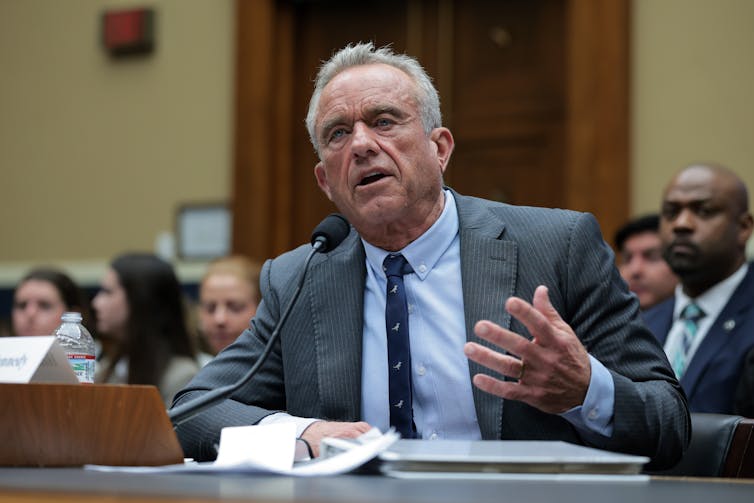
Morsa Images/DigitalVision via Getty Images
Jane Tavares, UMass Boston and Marc Cohen, UMass Boston
When you lose your health insurance or switch to a plan that skimps on preventive care, something critical breaks.
The connection to your primary care provider, usually a doctor, gets severed. You stop getting routine checkups. Warning signs get missed. Medical problems that could have been caught early become emergencies. And because emergencies are both dangerous and expensive, your health gets worse while your medical bills climb.
As gerontology researchers who study health and financial well-being in later life, we’ve analyzed how someone’s ties to the health care system strengthen or unravel depending on whether they have insurance coverage. What we’ve found is simple: Staying connected to a trusted doctor keeps you healthier and saves the system money. Breaking that link does just the opposite.
And that’s exactly what has us worried right now. Members of Congress are debating whether to make major cuts to Medicaid and other social safety net programs. If the Senate passes its own version of the tax-and-spending package that the House approved in May 2025, millions of Americans will soon face exactly this kind of disruption – with big consequences for their health and well-being.
How people end up uninsured
Someone can lose their health insurance for a number of reasons. For many Americans, coverage is tied to employment. Being fired, retiring before you turn 65 and become eligible to enroll in the Medicare program, or even getting a new job can mean losing insurance. Others wind up uninsured due to a different array of changes: moving to a different state, getting divorced or aging out of a parent’s plan after their 26th birthday.
And those who buy their own coverage may find that they can no longer afford the premiums. In 2024, average premiums on the individual market exceeded more than US$600 per month for many adults, even with subsidies.
Government-sponsored insurance programs can also leave you vulnerable to this predicament. The Senate is currently considering its own version of a tax-and-spending bill the House of Representatives passed in May that would make cuts and changes to Medicaid. If the provisions in the House bill are enacted, millions of Americans who get health insurance through Medicaid – a health insurance program jointly run by the federal government and the states that is mainly for people who have low incomes or disabilities – would lose their coverage, according to the nonpartisan Congressional Budget Office.
Consequences of becoming uninsured
Health insurance is more than a way to pay medical bills; it’s a doorway into the health care system itself. It connects people to health care providers who come to know their medical history, their medications and their personal circumstances.
When that door closes, the effects are immediate. Uninsured people are much less likely to have a usual source of care – typically a doctor or another primary care provider or clinic you know and trust. That relationship acts as a foundation for managing chronic conditions, staying current with preventive screenings and getting guidance when new symptoms arise.
Researchers have found that adults who go uninsured for even six months become significantly more likely to postpone care or forgo it altogether to save money. In practical terms, this means they’re less likely to be examined by someone who knows their medical history and can spot red flags early.
The Affordable Care Act, the landmark health care law enacted during the Obama administration, made the number of Americans without insurance plummet. The share of people without insurance fell from 16% in 2010 to 7.7% in 2023.
The people who got insurance coverage, particularly those who were middle age, saw big improvements in their health.
Researching the results
In research that looked at data collected from 2014 to 2020, we followed what happened to 12,000 adults who were 50 or older and lived across the nation.
Our research team analyzed how their experiences changed when they lost, and sometimes later regained, a regular source of care during those six years.
Many of the participants in this study had multiple chronic conditions like diabetes, hypertension and heart disease.
Those who didn’t see the same provider on a regular basis were far less likely to feel heard or respected by health care professionals. They had fewer medical appointments, filled fewer prescriptions and were less likely to follow through with recommended treatments.
Their health also deteriorated considerably over the six years. Their blood pressure and blood sugar levels rose, and they had more elevated indicators of kidney impairment compared with their counterparts who had regular care providers.
The longer they went without consistent health care, the worse these clinical markers became.
Warning signs
Preventive care is one of the best tools that both patients and their health care providers have to head off major health problems. This care includes screenings like cholesterol and blood pressure checks, mammograms, PAP smears and prostate exams, as well as routine vaccinations. But most people only get preventive care when they stay engaged with the health care system.
And that’s far more likely when you have stable and comprehensive health insurance coverage.
Our research team also examined what happened to preventive care based on whether the participants had a regular doctor. We found that those who kept seeing the same providers were almost three times more likely to get basic preventive services than those who did not.
Over time, these missed preventive care opportunities can add up to a big problem. They can turn what could have been a manageable issue into an emergency room visit or a long, expensive hospital stay.
For example, imagine a man in his 50s who no longer gets cholesterol screenings after losing insurance coverage. Over several years, his undiagnosed high cholesterol leads to a heart attack that could have been prevented with early medication. Or a woman who skips mammograms because of out-of-pocket costs, only to face a late-stage cancer diagnosis that might have been caught years earlier.

FS Productions/Tetra images via Getty Images
Shifting the costs
Patients whose conditions take too long to be diagnosed aren’t the only ones who pay the price.
We also studied how stable care relationships affect health care spending. To do this, we linked Medicare claims cost data to our original study and tracked the medical costs of the same adults age 50 and older from 2014 to 2020. One of our key findings is that people with regular care providers were 38% less likely to incur above-average health care costs.
These savings aren’t just for patients – they ripple through the entire health care system. Primary care stability lowers costs for both public and private health insurers and, ultimately, for taxpayers.
But when people lose their health care coverage, those savings disappear.
Emergency rooms see more uninsured patients seeking care that could have been handled earlier and more cheaply in a clinic or doctor’s office. While hospitals are legally required to provide emergency care regardless of a patient’s ability to pay, much of the resulting cost goes unreimbursed.
Hospitals foot the bill for about two-thirds of those losses. They pass the other third along to private insurance companies through higher hospital fees. Those insurers, in turn, raise their customers’ premiums. Larger taxpayer subsidies can then be required to keep hospitals open.
Seeing Medicaid as a lifeline
For the nearly 80 million Americans enrolled in Medicaid, the program provides more than coverage.
It contributes to the health care stability our research shows is critical for good health. Medicaid makes it possible for many Americans with serious medical conditions to have a regular doctor, get routine preventive services and have someone to turn to when symptoms arise – even when they have low incomes. It helps prevent health care from becoming purely crisis-driven.
As Congress considers cutting Medicaid funding by hundreds of billions of dollars, we believe that lawmakers should realize that scaling back coverage would break the fragile links between millions of patients and the providers who know them best.
Jane Tavares, Senior Research Fellow and Lecturer of Gerontology, UMass Boston and Marc Cohen, Professor of Gerontology, UMass Boston
This article is republished from The Conversation under a Creative Commons license. Read the original article.





























































